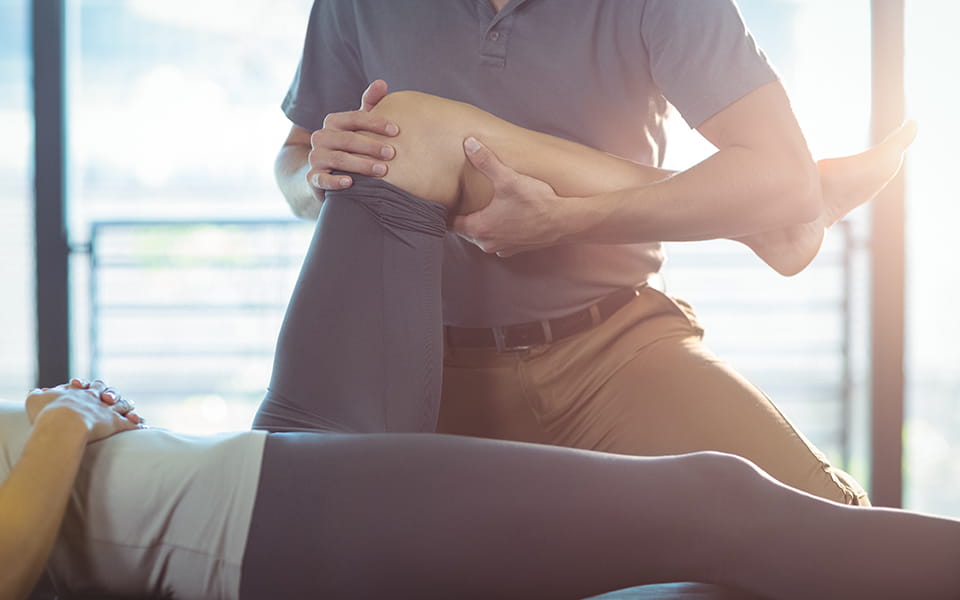How A Unique Approach Can Treat – and Prevent – Knee Ligament Injuries
April 30, 2018

The human knee joint is a remarkable example of bioengineering at its finest. The largest and most complex joint in the human body, each knee is an intricate system of bones, tendons, meniscus (cartilage), ligaments and bursa – small fluid-filled sacs that reduce friction between the different knee tissues and prevent inflammation. For added protection, each knee joint is encased in a membranous bag that contains synovial fluid, which lubricates and nourishes the joint.
Supported by the quadriceps, hamstring and gluteal muscles, our knees not only bear our weight for a lifetime, they allow us to walk, run, jump, bend, twist and pivot. In addition, they provide support and stability and act as shock absorbers for the body. Because they are so complex and are made up of so many moving parts, knees are highly vulnerable to stress-related injuries, particularly among recreational and professional athletes of all ages.
ACL Injuries Are a Common Injury
Of the four main knee ligaments - elastic bands of tissue that connect bones to each other – the anterior cruciate ligament (ACL) is the one most frequently injured during sports activities. Located in the center of the knee, the ACL controls the rotation and forward movement of the shin bone (tibia) and is most often injured or torn by a sudden twisting motion in the knee when an athlete lands incorrectly or stops suddenly. ACL tears are one of the most devastating and frequent injuries of the knee.
Once considered an adults-only injury, ACL tears are being seen increasingly in young athletes, some as young as 10 years old. “Kids are taking up sports at earlier ages and often play year-round, which may explain the increased incidence of this type of knee injury,” says James Voos, MD, Medical Director, University Hospitals Sports Medicine Institute. And, recent studies have shown that young female athletes are two to eight times more likely to injure their ACL than young males. Although there are many theories, the exact reasons for this have yet to be determined.
Because of the increasing incidence of ACL tears, UH Sports Medicine has developed a unique three-pronged approach to not only treat ACL injuries, but to prevent them from occurring in the first place.
Outreach: Outreach programs aimed at preventing injury are offered at more than 40 Northeast Ohio high schools and colleges. Our UH-sponsored athletic trainers collaborate with team physicians and coaches to treat injuries, prevent re-injury and ensure a safe return to play.
Minimally Invasive Surgical Techniques: When conservative treatments such as medications, strengthening exercises, braces and ice packs are not enough to treat the injury, surgery may be necessary. The sports medicine physicians at UH are trained in the most advanced, minimally invasive surgical techniques that result in minimal trauma to the knee, smaller incisions, less pain and shorter recovery times.
Prehab and Rehab: When surgery is determined to be necessary, athletes will begin prehab days to weeks before the procedure. During this time, our physical therapists work with the individual to enhance their lower extremity function through a series of muscle strengthening exercises. This pre-surgery prep helps to ensure an optimal surgical outcome.
After surgery, the prescribed physical therapy focuses on neuromuscular training to rebuild strength and regain range of motion, while controlling pain and inflammation. This process usually takes about three months, as the athlete gets used to using that leg again. Rehab exercises then continue at home to build strength and endurance. Six months after surgery, patients return to UH for more sports-specific training. It may take up to a year before an athlete is physically and mentally ready to return to competition.
Another component of the UH Sports Medicine ACL injury prevention program is called Jump Start. This program involves a series of exercises to strengthen and stabilize the knee as well as develop overall strength, agility, stamina and balance. It also provides instruction on technique, teaching athletes to land in a softer, safer position to protect the ACL from injury.
“Jump training is not just about injury prevention,” says Amanda Weiss Kelly, MD, Division Chief of Pediatric Sports Medicine at University Hospitals Rainbow Babies & Children’s Hospital. “It also makes athletes faster and stronger and helps them jump higher, which is advantageous in all sports.”


